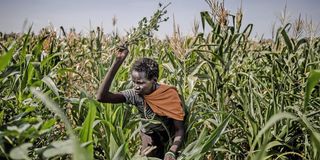M’Mailutha: We must build resilience of agriculture to survive ever-increasing threats

A farmer tries to scare away hopper bands of the desert locust on her maize crops in Turkana County. The triple threat of Covid-19, locust invasion and weather variability have had a drastic impact on farm production.
What you need to know:
- Smallholder farmers depend on farm-level production for nourishment and income to support their families pay for education, healthcare and other essential expenses.
- Indeed, for Kenya’s agri-food sector to transform in a meaningful way and enhance farmers’ livelihoods and incomes, we must commit to substantively support it.
- First, the development of the Agricultural Sector Transformation and Growth Strategy (ASTGS), a ten-year blueprint to transform the sector is a step in the right direction.
The Covid-19 pandemic has revealed the vulnerability of the agri-food value chain to external shocks, thus there is need for stakeholders to help build resilience of the sector.
For millions of families, the impact of Covid-19 is catastrophic. Smallholder farmers depend on farm-level production for nourishment and income to support their families pay for education, healthcare and other essential expenses.
The pandemic adds to the burden of locust invasion, weather variability, and increased pests and diseases.
Consequently, it is important for all stakeholders to mitigate the impact of these crises by supporting farmers to build resilience.
Indeed, for Kenya’s agri-food sector to transform in a meaningful way and enhance farmers’ livelihoods and incomes, we must commit to substantively support it.
It is strategic and visionary to support farmers as they undergird the country’s Gross Domestic Product (GDP) and are the only pathway to industrialisation, meaningful socio-economic transformation and sustainable growth and development.
Budgetary allocation
The budgetary allocation to the sector needs to reflect the country’s fidelity to the Malabo Declaration, which commits African governments to dedicate 10 per cent of GDP to the agricultural sector.
Kenya is yet to meet this commitment; a glaring shame for a country so dependent on agriculture.
The government has gotten it right on several fronts. First, the development of the Agricultural Sector Transformation and Growth Strategy (ASTGS), a ten-year blueprint to transform the sector is a step in the right direction.
Second, there is creation of the Warehouse Receipt Council to operationalise the warehouse receipt system for coffee, tea, maize, rice, beans and tea.
Third, the envisaged commodity exchange (COMEX) and fourth, the plan for the national farmer registration, which the Kenya National Farmers’ Federation (KENAFF) and the Agriculture and Food Authority (AFA) shall play a key role, are the desirable changes in the strategic food management framework.
The triple threat of Covid-19, locust invasion and weather variability have had a drastic impact on farm production.
Thus, we must build resilience to enable farmers access reliable markets and prioritise the participation and well-being of women, youths and persons with disabilities.
Collectively, we can enable smallholder farmers in Kenya to create employment and wealth through on-farm and off-farm enterprises, connect to markets and build quality and progressively sustainable livelihoods for their families, communities and the nation.
The writer is the CEO of the Kenya National Farmers Federation (KENAFF) email: [email protected]




